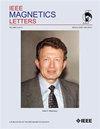Pt溅射过程中气体成分对CoFeB薄膜结构和磁性能的影响
IF 1.1
4区 物理与天体物理
Q4 ENGINEERING, ELECTRICAL & ELECTRONIC
引用次数: 0
摘要
超薄Ta/CoFeB/Pt三层结构与广泛的自旋电子应用有关,从磁性隧道结到skyrmionics器件。控制CoFeB层中的垂直磁各向异性、Gilbert阻尼和Dzyaloshinskii–Moriya相互作用(DMI)是这些应用的关键。我们研究了在直流磁控溅射过程中,在Ar、Kr和Xe工作气体环境中,在Ta/CoFeB/Pt三层的Pt覆盖层沉积过程中溅射气体成分的作用。当溅射气体的分子量从Ar增加到Kr再增加到Xe时,Pt层的密度降低(从21到15g/cm3)在三层膜的镜面X射线反射率测量中是明显的。观察到对吉尔伯特阻尼和界面DMI能量的显著影响,阻尼从0.037(1)增加到0.042(1)到0.048(1),界面DMI从0.47(4)mJ/m2减少到0.45(5)mJ/m2-0.39(4)m J/m2。通过明智的界面控制来控制这些材料的垂直磁化和DMI强度的能力是实现在较小横向尺寸下具有更好稳定性的磁性器件的一种手段,这是自旋电子器件阵列器件缩放的关键。本文章由计算机程序翻译,如有差异,请以英文原文为准。
Effect of Gas Composition During Pt Sputtering on Structural and Magnetic Properties of CoFeB Thin Films
Ultrathin Ta/CoFeB/Pt trilayer structures are relevant to a wide range of spintronic applications, from magnetic tunnel junctions to skyrmionics devices. Controlling the perpendicular magnetic anisotropy, Gilbert damping, and Dzyaloshinskii–Moriya interaction (DMI) in the CoFeB layer is key for these applications. We examine the role of sputter gas composition during the Pt overlayer deposition of a Ta/CoFeB/Pt trilayer in Ar, Kr, and Xe working gas environments during direct current magnetron sputtering. The decreasing density of the Pt layer (from 21 to 15 g/cm
3
) was apparent in specular X-ray reflectivity measurements of the trilayer films when increasing the molecular weight of the sputtering gas from Ar to Kr to Xe. Significant effects on the Gilbert damping and the interfacial DMI energy were observed, with increases in the damping from 0.037(1) to 0.042(1) to 0.048(1), and reductions in the interfacial DMI from 0.47(4) mJ/m
2
to 0.45(5) mJ/m
2
to 0.39(4) mJ/m
2
. The ability to control the perpendicular magnetization and DMI strength of these materials through judicious interfacial control is a means toward magnetic devices with better stability at smaller lateral dimensions, the key to device scaling for spintronic device arrays.
求助全文
通过发布文献求助,成功后即可免费获取论文全文。
去求助
来源期刊

IEEE Magnetics Letters
PHYSICS, APPLIED-
CiteScore
2.40
自引率
0.00%
发文量
37
期刊介绍:
IEEE Magnetics Letters is a peer-reviewed, archival journal covering the physics and engineering of magnetism, magnetic materials, applied magnetics, design and application of magnetic devices, bio-magnetics, magneto-electronics, and spin electronics. IEEE Magnetics Letters publishes short, scholarly articles of substantial current interest.
IEEE Magnetics Letters is a hybrid Open Access (OA) journal. For a fee, authors have the option making their articles freely available to all, including non-subscribers. OA articles are identified as Open Access.
 求助内容:
求助内容: 应助结果提醒方式:
应助结果提醒方式:


